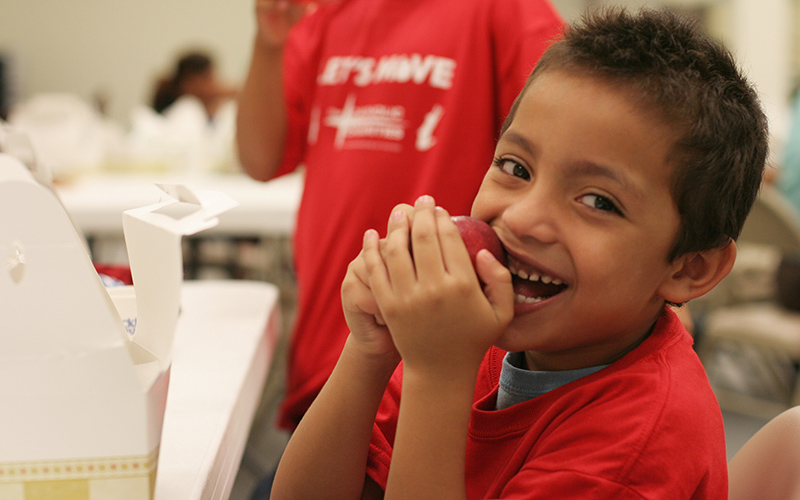
The Summer Food Service Program offers free meals in the summer to low-income kids, like this boy in Chicago, to make up for the loss of school-year meals. Arizona’s program appears to be rebounding this summer after steady declines. ( Photo by U.S. Department of Agriculture/Creative Commons)
WASHINGTON – Advocates and Arizona education officials say they are confident the summer meal program for low-income children will start to climb this summer, after five years of steady declines that saw meals served drop more than 50 percent.
Final numbers will not be available until this fall, but officials point to an increase in the number of serving sites, a new focus on the basics of the program and more outreach efforts as indicators that the program will turn the corner.
Terra Masias, child nutrition program manager for St. Mary’s Food Bank Alliance, said her organization “absolutely” expects to see an increase in meals served this year, as it has been able to increase the number of serving sites it operates from 124 last year to 151 now.
That was echoed by Kenny Barnes, co-director of the community nutrition program for the Arizona Department of Education, who said it has been a “pretty productive summer” so far for the agency. As of the first of this week, the department had recruited 176 sponsors to run 1,028 sites, almost as many as the 184 sponsors and 1,098 sites from all of last summer, with more continuing to come in.
The Summer Food Service Program was “established to ensure that low-income children, ages 18 and younger, continue to receive nutritious meal meals when school is not session” by offering free meals to children, with many sites also offering adult meals at a reduced price.
The program is funded nationally by the U.S. Department of Agriculture and administered in Arizona by the state Department of Education, but actual meals are served by sponsoring organizations like YMCAs, food banks, churches and schools.
Since 2012, however, the number of meals and number of children served in Arizona has steadily fallen. Data from the USDA shows that attendance in Arizona fell from 27,554 children a day in 2012 to 12,691 a day in 2016, causing the total number of meals served to drop from almost 2.5 million to under 1.1 million over the same period.
The reduction in service came as childhood poverty rose slightly, from 24 percent of children in poverty to 25.6 percent, according to the Census Bureau.
Barnes blames part of the decline on bookkeeping, saying statistics in the past may have been “inflated” due to “issues with sponsors” – problems they now believe they have fixed. Barnes said that they have “beefed up the program integrity” and now that sponsors who operate the program are doing so “for the kids.”
See related story:
“The numbers now are more accurate and more real,” he said.
Education Department officials said they took many steps to improve this year’s program, with department spokesman Stefan Swiat saying in an email that the focus this year was “Back to Basics.”
“Not only did we discuss the basics of the SFSP program that some sponsors may have strayed from, we discussed promotion as well,” Swiat said.
Promotion is an important element of a successful program, said Julie Yee, spokeswoman for the USDA’s Western Regional Office.
“Promoting summer meals sites in a community is one of the most important things one can do to ensure no child goes hungry this summer,” she said in an email. “The more parents, children and teenagers know about where sites are located, the more children will come to eat.”
Promotion can be traditional outreach through community networks or more modern tools, like the Education Department’s “summer lunch buddies” campaign, which includes a clickable map showing meal service sites, hours and costs where adult meals are served.
Another effort is the national No Kid Hungry program, whose goal is to “make sure that children have access to healthy food wherever they are throughout the year.”
The texting service allows people to punch their location into their phone and then points them to the closest sites. The service aims to close what No Kid Hungry program manager Derrick Lambert calls an “awareness gap” for the summer meals program.
Barnes said one of the biggest hurdles this program faces is reaching isolated areas like rural locations and reservations, but they are working on it.
“This summer was the first year that the ADE (Arizona Department of Education) conducted a summer food and at-risk afterschool training on the reservation,” Swiat said, noting that Barnes and a colleague conducted a training in Window Rock on the Navajo Nation.
“As a result of that training, we had several new SFSP sponsors and sites that are participating this year,” Swiat said.
Masias said St. Mary’s has been focusing on rural areas. The food bank has been able to increase its sites in northern Arizona from three to eight, including a location in Aguila, which has an estimated population of just 1,066 people.
Masias said that their sites are open and that they encourage children to come and get a meal so that they “are more prepared for when school starts.”
Barnes said that kids and families in the program are “very appreciative” of the service.
“It shows as they walk through the door,” he said.